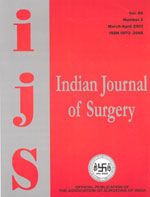
|
Indian Journal of Surgery
Medknow Publications on behalf of Association of Surgeons of India
ISSN: 0972-2068
Vol. 67, No. 1, 2005, pp. 34-37
|
 Bioline Code: is05005
Bioline Code: is05005
Full paper language: English
Document type: Research Article
Document available free of charge
|
|
|
Indian Journal of Surgery, Vol. 67, No. 1, 2005, pp. 34-37
| en |
Postoperative pain relief following abdominal operations: A prospective randomised study of comparison of patient controlled analgesia with conventional parenteral opioids
Vengadesh G Sri, Sistla Sarath Chandra, Smile S Robinson
Abstract
BACKGROUND: Parenteral opioids are traditionally used for pain management following abdominal operations. Patient Controlled Analgesia (PCA) is replacing the conventional method for postoperative pain relief nowadays.
AIMS: To find out the effectiveness of PCA in postoperative pain relief following abdominal operations.
SETTINGS AND DESIGN: This prospective randomised study was conducted in the Jawaharlal Institute of Post Graduate Medical Education and Research, Pondicherry, India.
MATERIALS AND METHODS: Sixty-two consecutive patients undergoing abdominal operations were randomly divided into PCA group (n=32) who received intravenous PCA morphine and IM group (n=30) who received conventional intramuscular morphine in the postoperative period. Morphine consumption, pain relief, detailed pulmonary function tests and side-effects of morphine were assessed.
STATISTICAL ANALYSIS: This was performed by "Epi Info 2000 version 6". Chi-square and Students 't' tests were used to relate the variables.
RESULTS: The total morphine consumption of the PCA group was significantly lesser than IM group (mean 30.84 mg versus 37.36 mg P-0.015) and it was less at different intervals in the postoperative period. The PCA group had better pain relief when compared to the IM group (mean pain score 3.42 versus 4.97 P<0.001). Pulmonary function parameters did not show a significant difference at different intervals in the postoperative period except for Peak Expiratory Flow Rate. None of the patients had major morphine-related complications.
CONCLUSIONS: Intravenous PCA provides better pain relief with less morphine consumption as compared to the conventional IM method. Recovery of postoperative pulmonary functions showed no significant difference in the two groups apart from Peak Expiratory Flow Rate, which showed significant early recovery in the PCA group.
Keywords
Pain relief, Patient controlled analgesia, Abdominal operations
|
| |
© Copyright 2005 Indian Journal of Surgery.
|
|
